After two years of only streaming of their biannual New York show online due to the pandemic, the Audio Engineering Society (AES) returned to their live event presentation format at the Javits Center in October 2022, and it was a resounding success. Part One of our AES Fall 2022 New York coverage (in Issue 176) referenced new gear showcases from companies like Neumann, Solid State Logic, Avid, and others, as well as a look at presentations from producer/engineers Susan Rogers and Jack Antonoff. Part Two continues with coverage of presentations from Produce Like a Pro’s Warren Huart and live concert multitrack recording pioneer David Hewitt, and Q&As with the legendary Bob Clearmountain and the inimitable Tchad Blake as part of the Mix With the Masters program hosted within AES 2022 New York.
David Hewitt with Warren Huart
Best known for Produce Like a Pro, his YouTube educational series on music production and engineering, British producer/engineer Warren Huart has also amassed an impressive list of album credits that include The Fray, Aerosmith, Korn, Colbie Caillat, Ace Frehley, the Ramones, and others. His YouTube series, which features equipment and microphone comparison shootouts, breakdowns on the production of popular records, and loads of engineering and production tips, made Huart an ideal person to moderate a Q&A with David Hewitt, who captivated the AES audience with his tales of being on the road, a number of which were not included in his recent book, On the Road: Recording the Stars in a Golden Era of Live Music (reviewed in Copper 170).
Prior to 1970, live recordings were primarily done in mono or stereo, with limited use of multitrack recording in the studio, and, in some situations, for television. The Concert for Bangladesh was one of the first concert events to be recorded by a multitrack recording-equipped remote truck, and it set a template for many iconic live recordings throughout the 1970s. David Hewitt was responsible for a large portion of these records: Peter Frampton’s Frampton Comes Alive!, Aerosmith’s Live Bootleg, Eric Clapton’s E.C. Was Here, The No Nukes Concerts, Live Aid, Jackson Browne’s Running On Empty, and Neil Young’s Live Rust are just a few of the hundreds of live releases that he recorded with his customized remote trucks. Additionally, Hewitt was responsible for the sound on numerous concert films, such as Young’s Rust Never Sleeps, the Rolling Stones’ Shine A Light, the Chuck Berry tribute Hail! Hail! Rock n Roll!, and U2’s Rattle and Hum.
Hewitt was a surprise featured speaker at AES, and was not listed in the original schedule. Nevertheless, his unique experience and expertise, combined with the historical context of so much of his work within the larger body of popular music and the magic of live performances, made for a large audience of attentive fans and engineering peers. With the quiet confidence forged by decades of experience in high-pressure situations, Hewitt was relaxed, and humorously nonchalant about many of his groundbreaking accomplishments.
When asked about which of his recordings were his first which were the most memorable, Hewitt quickly replied that he was most proud of Rust Never Sleeps as that was, in his opinion, the result of an entire cross country tour’s worth of work in which every show was different, but meeting a high standard of excitement and professionalism.
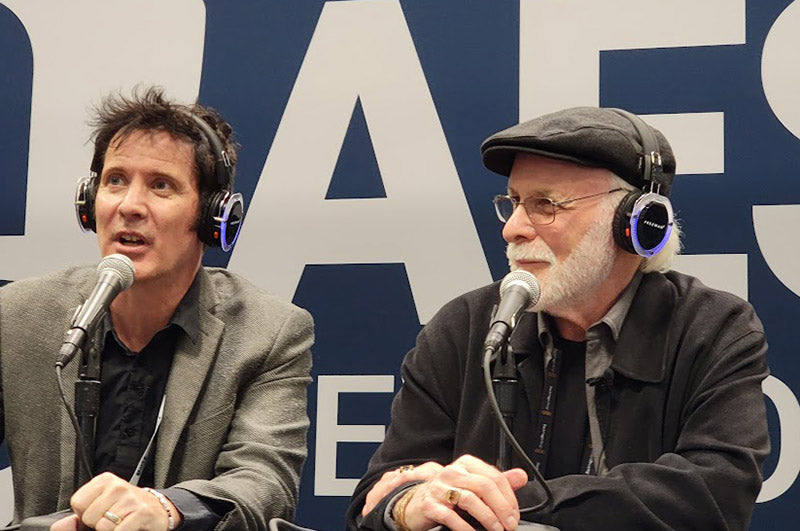
Warren Huart and David Hewitt. Courtesy of John Seetoo.
He recalled his first remote recording gig, which was the first-ever using the Record Plant truck. Hewitt joked that his only qualifications were that he was a known commodity from his Pennsylvania studio work, had done live mixing in the past, and knew how to drive a truck. They had to traverse through heavy snows in Buffalo, New York to record John McLaughlin’s Mahavishnu Orchestra, and an up-and-coming Boston band at the time named Aerosmith. The Aerosmith relationship would continue over subsequent years and records, with the band’s Live Bootleg, recorded in their cavernous rehearsal space, as one of the few “studio” recordings to his credit.
Hewitt recorded countless shows for the King Biscuit Flower Hour live concert radio broadcasts. (The show ran from 1973 to 1993.) He was particularly impressed by a then-barely-known Bruce Springsteen as an opening act at Manhattan’s Max’s Kansas City nightclub.
Hewitt was a pioneer in setting up state-of-the-art recording setups in his remote trucks. The original Record Plant truck was obtained from Wally Heider studios. He recalled that the truck had been designed for TV shows and was used for the Screen Gems TV program The Johnny Cash Show in the late 1960s. Hewitt noted that the recordings made with that truck (which included The Concert for Bangladesh) sounded great, even though it was limited to 4 or 8 tracks. Hewitt ultimately replaced the truck with two more modern vehicles with 16- and later, 24-track capability.
Perhaps this was a secret to the consistently pristine quality of his live remote recordings: Hewitt assiduously avoided the use of compression in his signal chain unless absolutely deemed necessary, at which point a UREI 1176 compressor/limiter was his outboard unit of preference.
Bearing in mind the Tom Dowd (acclaimed recording engineer) principle of always having the machines prepped so as not to lose a second of magic music making, Hewitt made it a policy to always have two Ampex 16-track machines set to run concurrently with overlaps to prevent losing any part of a performance. The Black truck would later be equipped with an API console and two Ampex 24-track recorders.
Hewitt chuckled about his friendly rivalry with British engineer Eddie Kramer, best known for his work with Jimi Hendrix, Kiss, and Yes. Kramer decided to go into head-to-head competition with Hewitt in the remote recording business. Kramer outfitted a truck sporting the latest equipment, and landed one particular artist based on his Hendrix association. However, Hewitt had the last laugh when the artist came to the Record Plant to mix tapes recorded on Kramer’s remote unit. Kramer had apparently not adhered to the Dowd principle, and a performance that was supposed to continue on another reel was blank! The furious artist then became a longtime Hewitt client.
An impressive percentage of attendees at the seminar had all either previously worked with Hewitt or trained with his former assistants and were all professional engineers in their own right, and skipped out on a concurrent presentation from prominent mixing engineer Chris Lord-Alge in order to hear Hewitt speak.
[An in-depth interview with David Hewitt will be forthcoming in a future issue of Copper – Ed.]
Bob Clearmountain and Tchad Blake
Engineer/producer Bob Clearmountain’s work on such iconic albums as Born In the USA (Bruce Springsteen), Avalon (Roxy Music) and Reckless (Bryan Adams) did nothing less than define an entire musical era sonically. Many of his techniques have become standard mixing protocols for recording engineers around the world, such as the use of chaining multiple digital delays, employing multiple reverbs – and using the Yamaha NS10 speakers as nearfield monitors placed atop a console. As a result, the sonically unforgiving NS10s, introduced in 1978, became ubiquitous in recording studios.
The list of hit records mixed or produced by Bob Clearmountain is simply staggering, and comprises a wide cross section of popular music, with best-sellers from the likes of the Rolling Stones, Hall and Oates, Chic, Simple Minds, Alejandro Sanz, David Bowie, INXS, Huey Lewis and the News, The Who, Paul McCartney, Ricky Martin, Aimee Mann….and the list goes on.
While perhaps not as well-known, multiple engineering Grammy winner Tchad Blake is equally regarded among his peers for his work with The Black Keys (Brothers), Sheryl Crow (The Globe Sessions), Pearl Jam, U2, Al Green, Elvis Costello, Crowded House, Los Lobos, Tom Waits, Suzanne Vega (Beauty & Crime), Richard Thompson, the Pretenders, and many others.
These two incredibly humble music production legends held court for a Mix With the Masters presentation to simply enjoy a discussion about recording, past projects, and questions from the packed crowd of fans, acolytes, and peers.
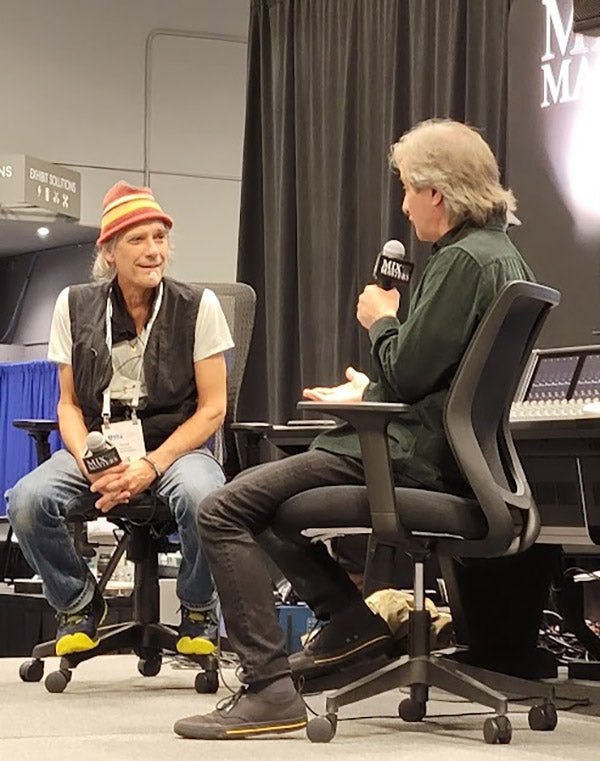
Tchad Blake and Bob Clearmountain. Courtesy of John Seetoo.
Sitting in front of an SSL console, the two began the conversation by joking a bit about tinnitus, with Clearmountain admitting that he has suffered from it for decades. Blake responded with the confession that he has lost a considerable amount of hearing in one of his ears, and says that he will often check a mix by listening with his good ear to one speaker and then shifting over to the other. Clearmountain, a diehard SSL fan, pointed out to Blake that the SSL has a button that will automatically switch the left and right speakers so that he wouldn’t have to change position! (For nearly the last decade, Blake has mixed “in the box” – totally in the computer on a virtual console.)
Blake confessed to being in awe of Clearmountain’s methodology when he once observed Clearmountain mixing Crowded House’s Woodface. Whereas Blake’s approach to mixing is to try different combinations of level, EQ and processing to arrive at a desired sound, Clearmountain mentally calculates the settings on his mixes to the point where he tells his assistant things like, “This Lexicon delay should be set for 15 milliseconds, panned 60/40 left to right, patched into a flanger with depth at X, rate, at Y and then into this AMS reverb set for 30 millisecond pre-delay with a truncated Hall patch…” without even hearing the tracks in advance. Blake was astounded when the sounds of the mix just magically appeared with little tweaking required.
On the topic of favorite mixes that each had done, their responses were surprising: both producer/engineers favored obscure works from their discographies.
Bob Clearmountain’s favorite was the album Tijuana Dreams by the Small Stars. Similar to Garth Brooks’ fictional rock persona of Chris Gaines, the Small Stars was a fictional “loser bar band” from Reno that in fact, was the Austin band Fastball.
Tchad Blake cited Ron Sexsmith, the self-titled debut album by the Canadian singer-songwriter, as his personal favorite. Blake recorded as well as mixed the record, which was produced by longtime collaborator Mitchell Froom.
Of all of the records he has worked on, Clearmountain admitted that the only one he felt in his gut was going to be “a surefire hit” was Good Times by Chic.

Bob Clearmountain. Courtesy of John Seetoo.
As his wife Betty is the CEO of hardware and software company Apogee Electronics, Bob Clearmountain has his own suite of customized plugins (add-ons to digital recording software). However, he affirmed that did not influence his opinion on the subject of analog vs. digital outboard effects. Both he and Blake concurred that plugins have reached a level of sophistication where they sound close enough to the actual outboard gear that engineers no longer have to feel they’re in a professionally-compromised situation by using them. The choice of using outboard hardware versus plugins is now more a matter of preferring their workflow convenience and tactile manipulation capability (using knobs versus a mouse) than of sonics.
That said, he explained that Apogee’s Clearmountain’s Domain is his personal plugin and features his custom effects chains, including a number of cascading delays designed exclusively for Sony Atmos immersive mixing.
Clearmountain and Blake also concurred on a number of engineering-related questions, such as:
- A preference for simple miking on drums but an insistence on stereo room mics.
- 85 dB level is the neutral maximum limit before volume-related sonic coloration sets in.
- Basic mixes on a track with solid performances, arrangements, and no corrections needed can be done in an average of two hours, and then details can be added.
- Always start with a rough mix; never mix by starting with tweaking individual instruments first.
As a nod to the adjacent NAB (National Association of Broadcasters) show that took place at the Javits Center concurrently with AES, Clearmountain noted that the era of multiple big studios has been decimated by the convenience of digital technology and laptop DAWs (digital audio workstations) and advised that more jobs are emerging in post-production for video than for music, the latter of which will likely require people with a broader range of skill sets other than just audio engineering in the future.
New Frontiers In Stereo Recording: The Secret Menu
While live presentations at AES were universally welcomed back, the consistently high bar set by AES’s live streaming video presentations during the pandemic was not forgotten. Among the various video workshops offered by AES for Fall 2022, one, in particular, touched on topics of prospective interest for Copper readers.
In New Frontiers in Stereo Recording: The Secret Menu, engineer and USC professor of screen scoring and music technology Christian Amonson shared some of the approaches, principles and techniques that have garnered much acclaim for the fidelity he has achieved on orchestral and other classical music recordings by artists like Yo-Yo Ma, John Williams, and others.
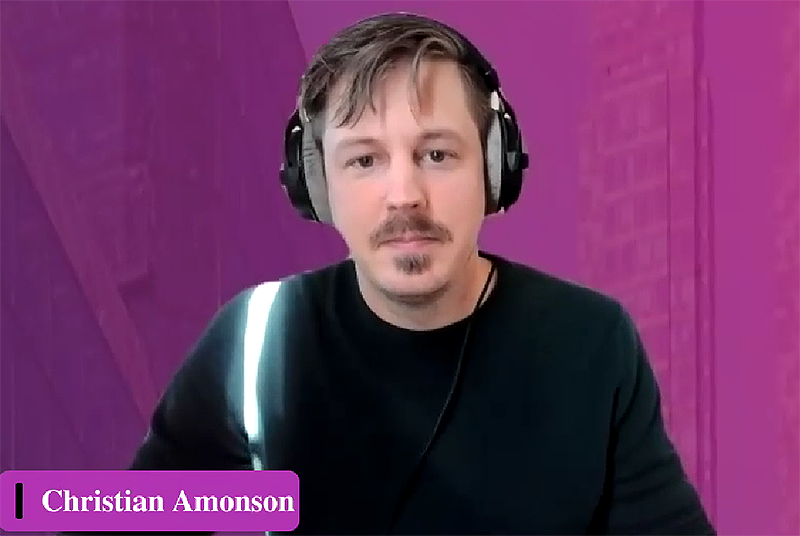
Christian Amonson. Courtesy of AES.
Amonson noted that a key problem with various mic placement techniques, such as XY, binaural, Blumlein and others is that they are all “static” in terms of how they capture sound. In order to overcome their fixed aural perspectives, Amonson explained several of the different microphone arrays that he and others have incorporated in recent years that can have the sonic “perspective” of what they capture adjusted in real time. While some of these mic placement techniques have been around in their original form for decades, others are more recent and variations have arisen to meet the demands of new technologies such as immersive mixing. These arrays include:
The Straus Paket – Amonson refers to this as “The O.G. of alternate mic placement.” It was developed by engineer Volker Straus and consists of taping an omnidirectional and cardioid pattern mic together and wiring them in series so that a much broader audio perspective could be achieved than with either mic on its own.

The Straus Paket mic technique. Courtesy of AES.
OCCO or O/C Array – this is an acronym for omni/cardioid/cardioid/omni, a horizontal bar grouping that has a stereo correlated cardioid pair on the inside and a stereo correlated omni pair on the outside, all on the same plane, which gives the recording engineer the choice to use all four of them or select pairs independently. This array provides a wide range of flexibility to accommodate changes in group configurations, venues, compositions, or songs, and even movements and phrases within a particular musical score.
Variations of the OCCO Array include the T-T Array, the Crawford Bar, the K-C Array and others, which keep the same principle but use different kinds of mics with specs to accommodate a wider stereo spread, or deal with unwanted reflections due to a venue’s stone or other highly reflective surfaces.
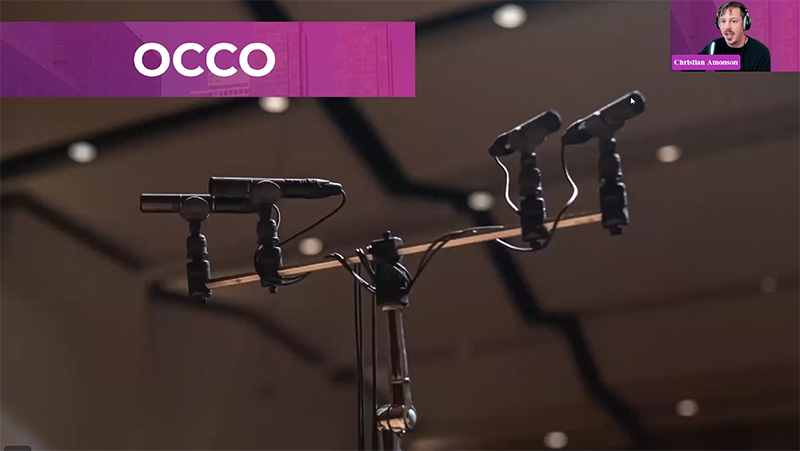
The OCCO Array. Courtesy of AES.
The principles of the O/C Array are not confined to live performance venues. Amonson explained using his modified array in the recording studio for a session by trumpeter Stan Curtis. This enabled Amonson to change the sense of depth in an instrument being recorded, and to also handle different instruments without the need to reposition the mics.
Another offshoot of the O/C Array is the OVVO, where the mic pair on the inside is a pair of selectable pickup pattern mics. This mic pair can deliver signals in both omni and cardioid patterns concurrently. Each pattern can be chosen individually or blended together concurrently during mixing.
The cardioid inner mics can be exchanged for subcardioid (for dead-sounding rooms) or hypercardioid (for excessively reverberant rooms) pairs at the engineer’s discretion, depending on which will work best for the music being recorded. Amonson believes that any good-sounding pair of mics can be suitable for these configurations.
One particular array that was successfully used for pipe organ is the proprietary X-Wing Array, which avoids the phase discrepancies of other mic arrays, resulting in a more “in your face” sound.
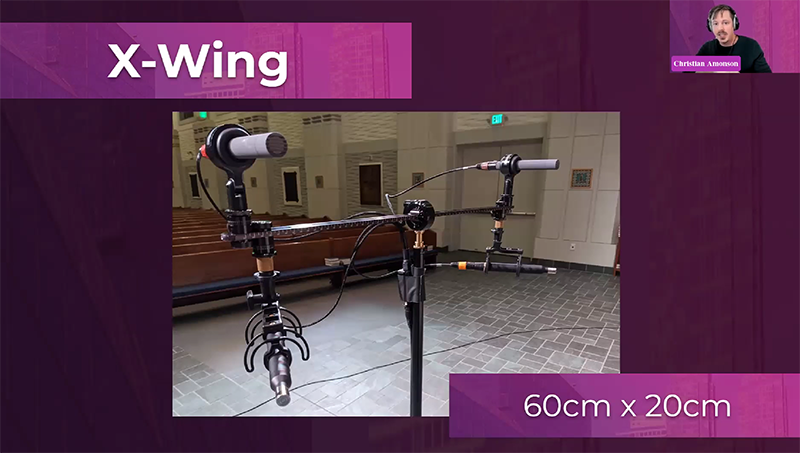
The X-Wing Array.
Another offshoot is the 8SS8 configuration, which consists of ribbon mics arranged in a figure-8 pattern, augmented by subcardioid mics. The 8SS8 array offers very wide room coverage, thanks to the figure-8 polar pattern on the outside mic pair. Amonson has successfully used this technique for orchestral recordings.
Amonson’s “secret menu” tips also include the following:
- Start with familiar microphone arrays.
- Look for contrasting mic pickup patterns.
- Play with contrasting vs. complimenting tone.
- Changing the mix ratios of the mic pairs is OK.
- Focus on the pattern/sum total of the sound of the array and not the sound of the mics themselves.
- Choose good-sounding mic pairs.
Amonson explained that when using multiple microphones in these configurations, the phase differences between the mics actually correspond more to human hearing, and can help to enhance a sense of realism when listening back to recordings made with these types of arrays.
His final tip was that there are no rules except making the final recording sound as good as possible, so adding additional pairs or changing the spacing or direction of mics in a configuration are perfectly fine if it makes the music sound better.
AES Fall 2022 was certainly a successful comeback event, and AES is to be commended on how they seamlessly integrated the best aspects of their live, in-person events and their streaming video presentations.













0 comments